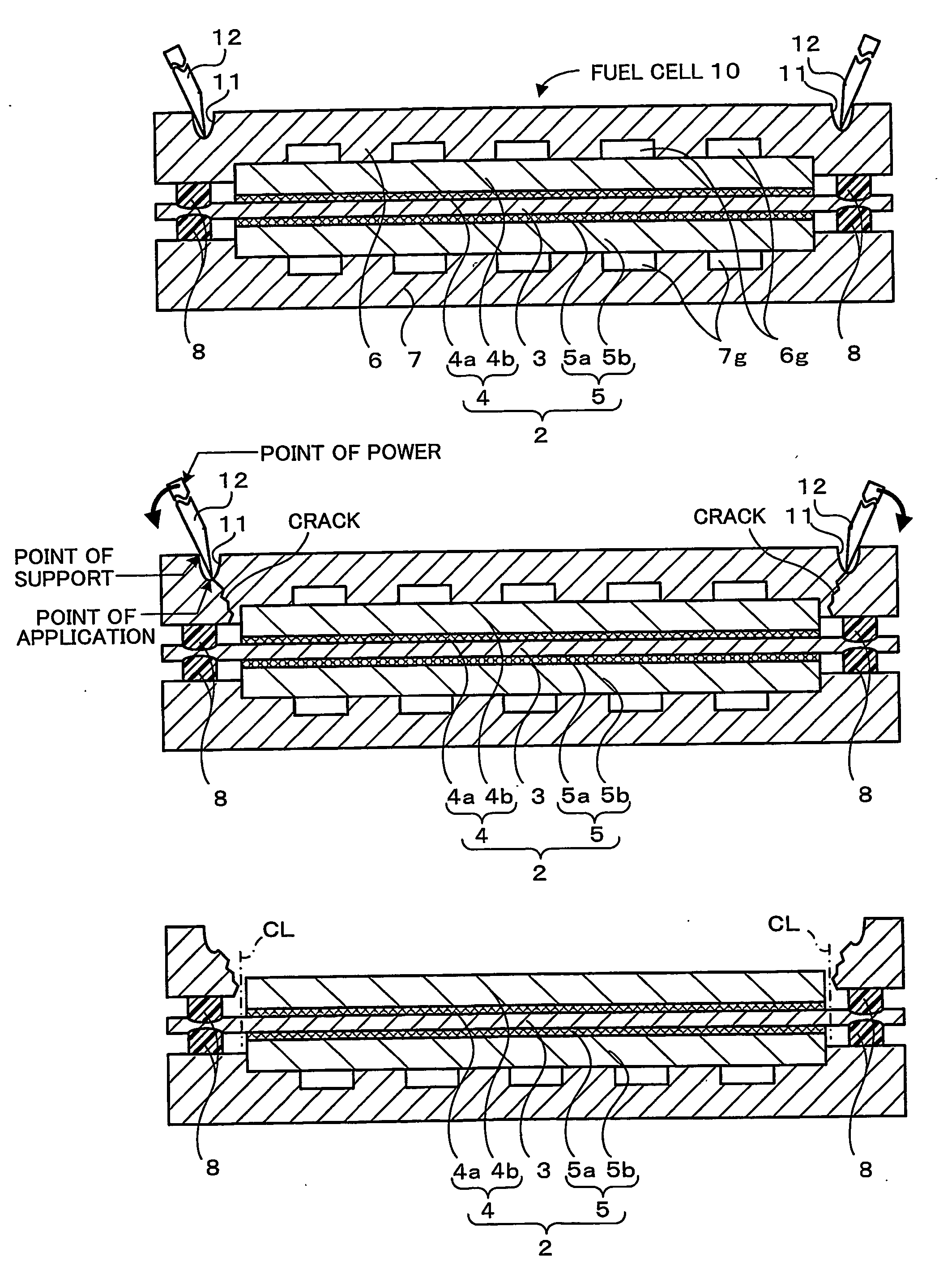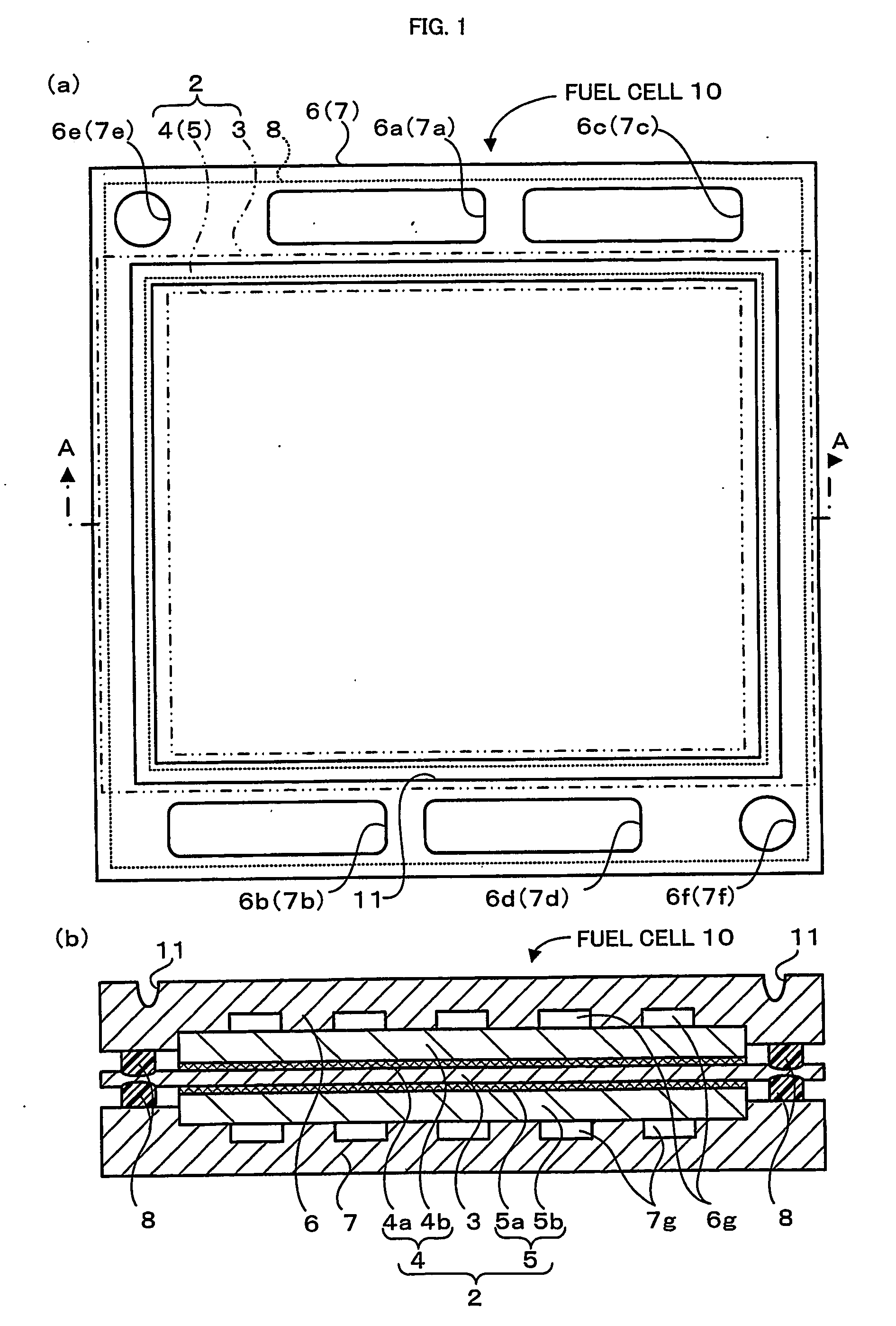Fuel cell, disassembly method thereof, and separators used therein
a technology of separators and fuel cells, which is applied in the direction of cell components, cell component details, manufacturing tools, etc., can solve the problems of insufficient movement of linear members, failure to remove sealing members, and damage to linear members, so as to achieve easy and accurate positioning and easy breakage
- Summary
- Abstract
- Description
- Claims
- Application Information
AI Technical Summary
Benefits of technology
Problems solved by technology
Method used
Image
Examples
first embodiment
[0071]FIG. 1 schematically illustrates the structure of a fuel cell 10 in a first embodiment of the invention. FIG. 1(a) is a plan view, and FIG. 1(b) is a sectional view taken on a line A-A in FIG. 1(a).
[0072] The fuel cell 10 of this embodiment is a polymer electrolyte fuel cell and includes, as main constituents, a membrane electrode assembly (hereafter referred to as MEA) 2 having an electrolyte membrane 3 interposed between a pair of electrodes 4 and 5, a pair of separators 6 and 7 arranged across the MEA 2, sealing members 8 located to surround the outer circumference of the MEA 2, and a recess 11 used as a breaking guide for breakage of one of the separators 6. The fuel cell 10 is a unit cell having an electromotive force in a range of about 0.6 to 0.8 V. A large number of the fuel cells 10 are tightly laid one upon another to form a direct current power source of several hundred volts as a power supply of, for example, a drive motor of the vehicle.
[0073] The MEA 2 has the ...
second embodiment
[0087]FIG. 10 schematically illustrates the structure of a fuel cell 20 in a second embodiment of the invention. FIG. 10(a) is a plan view, and FIG. 10(b) is a sectional view taken on a line C-C of FIG. 10(a).
[0088] The fuel cell 20 of this embodiment is a polymer electrolyte fuel cell and includes, as main constituents, an MEA 2 having an electrolyte membrane 3 interposed between a pair of electrodes 4 and 5, a pair of separators 6 and 7 arranged across the MEA 2, sealing members 8 located to surround the outer circumference of the MEA 2, and breaking guides 21 and 22 used for breakage of both the separators 6 and 7. The structures of the MEA 2, the separators 6 and 7, and the sealing members 8 are identical with those of the first embodiment and are thus not specifically described here. The like elements to those of the first embodiment are expressed by the like numerals and symbols.
[0089] The breaking guides 21 and 22 have recesses 21a and 22a formed on the other planes of the ...
third embodiment
[0096]FIG. 14 is a sectional view schematically illustrating the structure of a fuel cell 30 in a third embodiment of the invention. Like the sectional view of FIG. 1(b) in the first embodiment, this sectional view shows a cross section of the fuel cell cut in the direction of depth.
[0097] The fuel cell 30 of this embodiment is a polymer electrolyte fuel cell and includes, as main constituents, an MEA 2 having an electrolyte membrane 3 interposed between a pair of electrodes 4 and 5, a pair of separators 6 and 7 arranged across the MEA 2, sealing members 8 located to surround the outer circumference of the MEA 2, and breaking guides 31 used for breakage of both the separators 6 and 7. The structures of the MEA 2, the separators 6 and 7, and-the sealing members 8 are identical with those of the first embodiment and are thus not specifically described here. The like elements to those of the first embodiment are expressed by the like numerals and symbols.
[0098] The breaking guides 31...
PUM
| Property | Measurement | Unit |
|---|---|---|
| vertex angle | aaaaa | aaaaa |
| angle | aaaaa | aaaaa |
| electromotive force | aaaaa | aaaaa |
Abstract
Description
Claims
Application Information
 Login to View More
Login to View More - R&D
- Intellectual Property
- Life Sciences
- Materials
- Tech Scout
- Unparalleled Data Quality
- Higher Quality Content
- 60% Fewer Hallucinations
Browse by: Latest US Patents, China's latest patents, Technical Efficacy Thesaurus, Application Domain, Technology Topic, Popular Technical Reports.
© 2025 PatSnap. All rights reserved.Legal|Privacy policy|Modern Slavery Act Transparency Statement|Sitemap|About US| Contact US: help@patsnap.com



